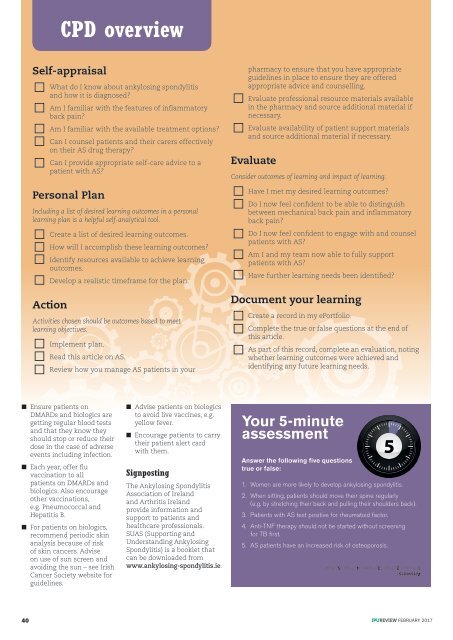Pharmacists in Smoking Cessation
IPU-Review-FEBRUARY-2017
IPU-Review-FEBRUARY-2017
You also want an ePaper? Increase the reach of your titles
YUMPU automatically turns print PDFs into web optimized ePapers that Google loves.
CPD overview<br />
Self-appraisal<br />
What do I know about ankylos<strong>in</strong>g spondylitis<br />
and how it is diagnosed?<br />
Am I familiar with the features of <strong>in</strong>flammatory<br />
back pa<strong>in</strong>?<br />
Am I familiar with the available treatment options?<br />
Can I counsel patients and their carers effectively<br />
on their AS drug therapy?<br />
Can I provide appropriate self-care advice to a<br />
patient with AS?<br />
Personal Plan<br />
Includ<strong>in</strong>g a list of desired learn<strong>in</strong>g outcomes <strong>in</strong> a personal<br />
learn<strong>in</strong>g plan is a helpful self-analytical tool.<br />
Create a list of desired learn<strong>in</strong>g outcomes.<br />
How will I accomplish these learn<strong>in</strong>g outcomes?<br />
Identify resources available to achieve learn<strong>in</strong>g<br />
outcomes.<br />
Develop a realistic timeframe for the plan.<br />
pharmacy to ensure that you have appropriate<br />
guidel<strong>in</strong>es <strong>in</strong> place to ensure they are offered<br />
appropriate advice and counsell<strong>in</strong>g.<br />
Evaluate professional resource materials available<br />
<strong>in</strong> the pharmacy and source additional material if<br />
necessary.<br />
Evaluate availability of patient support materials<br />
and source additional material if necessary.<br />
Evaluate<br />
Consider outcomes of learn<strong>in</strong>g and impact of learn<strong>in</strong>g.<br />
Have I met my desired learn<strong>in</strong>g outcomes?<br />
Do I now feel confident to be able to dist<strong>in</strong>guish<br />
between mechanical back pa<strong>in</strong> and <strong>in</strong>flammatory<br />
back pa<strong>in</strong>?<br />
Do I now feel confident to engage with and counsel<br />
patients with AS?<br />
Am I and my team now able to fully support<br />
patients with AS?<br />
Have further learn<strong>in</strong>g needs been identified?<br />
Action<br />
Activities chosen should be outcomes based to meet<br />
learn<strong>in</strong>g objectives.<br />
Implement plan.<br />
Read this article on AS.<br />
Review how you manage AS patients <strong>in</strong> your<br />
n Ensure patients on<br />
DMARDs and biologics are<br />
gett<strong>in</strong>g regular blood tests<br />
and that they know they<br />
should stop or reduce their<br />
dose <strong>in</strong> the case of adverse<br />
events <strong>in</strong>clud<strong>in</strong>g <strong>in</strong>fection.<br />
n Each year, offer flu<br />
vacc<strong>in</strong>ation to all<br />
patients on DMARDs and<br />
biologics. Also encourage<br />
other vacc<strong>in</strong>ations,<br />
e.g. Pneumococcal and<br />
Hepatitis B.<br />
n For patients on biologics,<br />
recommend periodic sk<strong>in</strong><br />
analysis because of risk<br />
of sk<strong>in</strong> cancers. Advise<br />
on use of sun screen and<br />
avoid<strong>in</strong>g the sun – see Irish<br />
Cancer Society website for<br />
guidel<strong>in</strong>es.<br />
AVAILABLE ONLINE<br />
AND IN-STORE!<br />
n Advise patients on biologics<br />
to avoid live vacc<strong>in</strong>es, e.g.<br />
yellow fever.<br />
Document your learn<strong>in</strong>g<br />
Create a record <strong>in</strong> my ePortfolio.<br />
Complete the true or false questions at the end of<br />
this article.<br />
As part of this record, complete an evaluation, not<strong>in</strong>g<br />
whether learn<strong>in</strong>g outcomes were achieved and<br />
identify<strong>in</strong>g any future learn<strong>in</strong>g needs.<br />
Your 5-m<strong>in</strong>ute<br />
assessment<br />
n Encourage patients to carry<br />
their patient alert card<br />
Digestive<br />
with them.<br />
and Imm<br />
Answer the follow<strong>in</strong>g five questions<br />
true or false:<br />
Signpost<strong>in</strong>g<br />
1. Women are more likely to develop ankylos<strong>in</strong>g spondylitis.<br />
The Ankylos<strong>in</strong>g Spondylitis<br />
Association of Ireland<br />
and Arthritis Ireland<br />
provide <strong>in</strong>formation and<br />
support to patients and<br />
2. When sitt<strong>in</strong>g, patients should move their sp<strong>in</strong>e regularly<br />
Support<br />
(e.g. by stretch<strong>in</strong>g<br />
for<br />
their back and pull<strong>in</strong>g<br />
Life<br />
their shoulders back).<br />
3. Patients with AS test positive rheumatoid factor.<br />
healthcare professionals.<br />
4. Anti-TNF therapy should not be started without screen<strong>in</strong>g<br />
SUAS (Support<strong>in</strong>g and<br />
for TB first.<br />
Understand<strong>in</strong>g Ankylos<strong>in</strong>g<br />
Spondylitis) is a booklet that<br />
can be downloaded from<br />
www.ankylos<strong>in</strong>g-spondylitis.ie.<br />
5. AS patients have an <strong>in</strong>creased risk of osteoporosis.<br />
Answers:<br />
1. False. 2. True. 3. False. 4. True. 5. True.<br />
40<br />
IPUREVIEW FEBRUARY 2017


